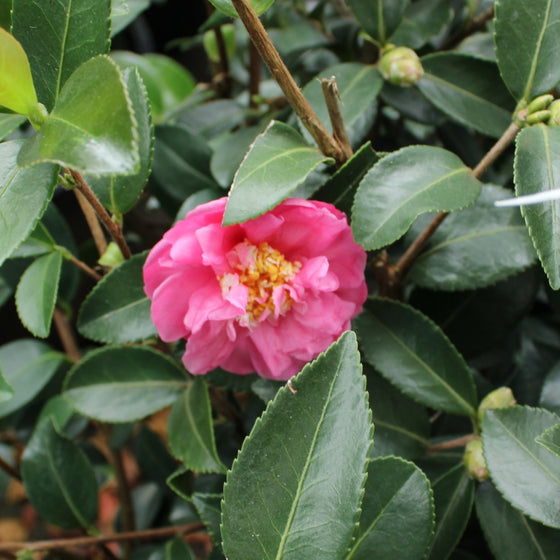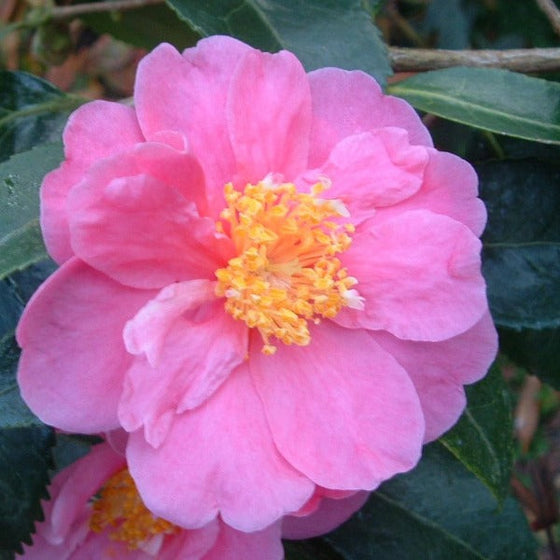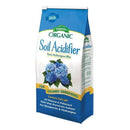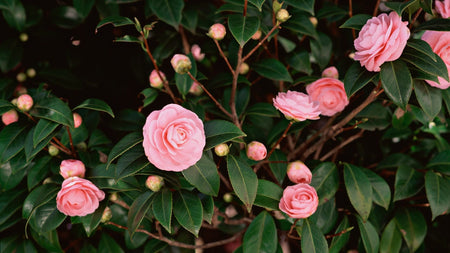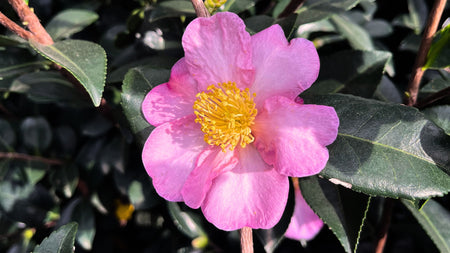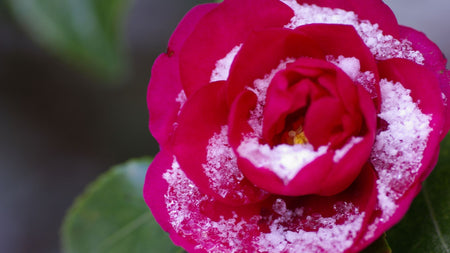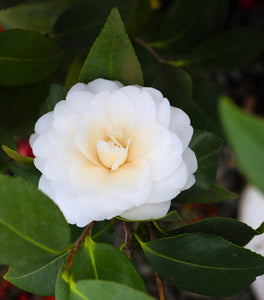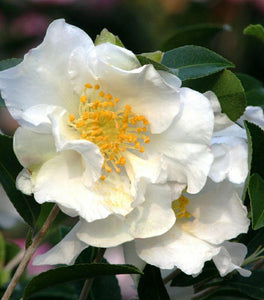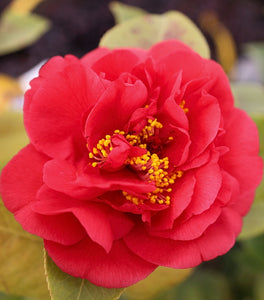
Images Depict Mature Plants
Camellia Winter's Joy Shrubs for Sale Online
Camellia Winter's Joy is a stunning evergreen shrub that adds year-round beauty and cheerful winter color to any landscape. This cold-hardy hybrid camellia produces an abundance of semi-double, rosy-pink blooms from late fall through early winter, providing a burst of vibrant color when most other plants are dormant. Winter's Joy's lush, glossy dark green foliage makes it an attractive addition to the garden even when not in bloom, offering visual interest and structure throughout the year. Growing 6 to 8 feet tall and 4 to 6 feet wide, it's ideal for a privacy screen, accent plant, or backdrop in mixed borders.
Camellia Winter's Joy thrives in USDA Zones 6-9 and is known for its ability to tolerate colder temperatures compared to many traditional camellia varieties. For best results, plant it in a location with partial shade, as too much direct sunlight can damage the blooms and foliage. This camellia prefers well-drained, acidic soil enriched with organic matter to ensure healthy growth and abundant flowering. Use Winter's Joy as a foundation planting, incorporate it into a woodland garden, or place it where its beautiful winter blooms can be enjoyed up close.
It is low maintenance and easy to care for, but Camellia Winter's Joy requires minimal pruning—just a light trim after flowering to maintain shape and remove any damaged branches. Applying an acid-loving fertilizer in early spring helps promote vigorous growth and sets the stage for a profusion of winter flowers. Mulching around the base helps retain moisture and keeps the roots cool during warmer months. With its spectacular winter blooms and reliable evergreen foliage, Camellia Winter's Joy is an excellent choice for adding year-round color and interest to your garden.
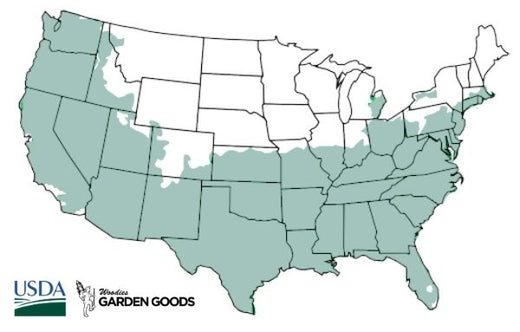
| Hardiness Zone: | 6-9 |
|---|---|
| Mature Height: | 6-8 feet |
| Mature Width: | 4-6 feet |
| Classification: | Broad leaved evergreen shrub, fall flowering |
| Sunlight: | Full Sun to Part Shade |
| Habit: | Evergreen, densely branched |
| Flower Color: | Pink, semi-double flowers |
| Foliage: | Dark green |
| Soil Condition: | Any well drained soil |
| Water Requirements: | Water well until established |
| Uses: | Extremely attractive when used as a focal point in the mixed border, mass planting, or a specimen planting. Provides unmatched winter interest due to its flowering in the early winter |
How to Care for Camellia Winter's Joy
Be sure to read our planting instructions to ensure a healthy and happy Camellia Winter's Joy for years to come!
How do I Plant A Camellia Winter's Joy Shrub?
To plant a Camellia Winter's Joy shrub, start by selecting a location with partial shade, as this will protect the shrub from intense afternoon sunlight, which can scorch the leaves. Ensure the planting site has well-drained, slightly acidic soil, enriched with organic matter such as compost or peat moss, to provide the ideal growing environment. Dig a hole twice as wide and the same depth as the root ball to allow the roots room to spread comfortably. Place the shrub in the hole so that the top of the root ball is level with the surrounding soil. Backfill with a mixture of native soil and compost, and gently firm the soil around the base to eliminate air pockets. Water thoroughly after planting to help the roots settle, and apply a 2-3 inch layer of mulch around the base to retain moisture and regulate soil temperature. Camellia Winter's Joy should be planted in spring or fall when temperatures are mild, allowing it to establish before facing the extreme heat of summer or the chill of winter. If planting multiple shrubs, space them about 4 to 6 feet apart to ensure good air circulation and accommodate their mature size. This spacing will also help prevent issues with pests and disease. During the first growing season, water regularly to help establish a strong root system, ensuring the soil stays consistently moist but not waterlogged. Once established, Camellia Winter's Joy will be more drought-tolerant, but it still benefits from consistent watering during dry periods. With proper planting and care, your Camellia Winter's Joy shrub will reward you with vibrant pink blooms and lush evergreen foliage for years to come.
How do I Water A Camellia Winter's Joy Shrub?
Watering a Camellia Winter's Joy shrub properly is essential for its healthy growth and beautiful winter blooms. During the first growing season, water the plant deeply once or twice a week, ensuring that the soil stays consistently moist but not waterlogged. Deep watering helps establish a robust root system, which is crucial for the shrub’s long-term health. Use a soaker hose or drip irrigation to deliver water directly to the root zone, minimizing evaporation and keeping the foliage dry. Early morning is the best time to water, as it allows excess moisture on the leaves to dry quickly, reducing the risk of fungal disease. Once your Camellia Winter's Joy is well-established, it will require less frequent watering but still needs consistent moisture during hot, dry periods or when blooming. Monitor the soil moisture regularly and water whenever the top few inches of soil feel dry to the touch. To help retain soil moisture and maintain even temperatures, apply a 2-3 inch layer of mulch around the base of the shrub, taking care not to let the mulch touch the trunk directly. Avoid overwatering, as camellias are susceptible to root rot in poorly drained conditions. By following a proper watering routine, your Camellia Winter's Joy will thrive, rewarding you with lush evergreen foliage and stunning pink winter flowers.
How do I Fertilize A Camellia Winter's Joy Shrub?
Fertilizing a Camellia Winter's Joy shrub is key to promoting healthy growth and abundant blooms. Start fertilizing in early spring, after the last frost, to encourage new growth and prepare the shrub for its next blooming cycle. Use a slow-release fertilizer specifically formulated for acid-loving plants like camellias, azaleas, and rhododendrons, as Camellia Winter's Joy prefers slightly acidic soil. Spread the fertilizer evenly around the root zone, making sure to keep it away from the trunk to avoid potential damage. After applying the fertilizer, water thoroughly to help the nutrients reach the root system and support healthy absorption. To keep your Camellia Winter's Joy thriving, apply another round of fertilizer in early summer, but avoid feeding the shrub in late summer or fall, as this can stimulate new growth that is vulnerable to frost damage. If your camellia shows signs of nutrient deficiency—such as yellowing leaves—consider supplementing with organic matter, like compost or well-aged manure, to enrich the soil. Mulching with organic materials such as pine bark or pine needles also helps maintain the desired acidity of the soil while conserving moisture. Proper fertilization will ensure that your Camellia Winter's Joy remains vigorous, producing beautiful pink blooms each winter and lush evergreen foliage throughout the year.

How do I Prune A Camellia Winter's Joy Shrub?
Pruning a Camellia Winter's Joy shrub is an important step in maintaining its shape, promoting healthy growth, and encouraging prolific blooms. The best time to prune is right after the flowering period, which typically ends in late winter to early spring. Pruning immediately after blooming helps preserve the new buds that will form for next season. Begin by removing any dead, damaged, or diseased branches to improve airflow and reduce the risk of pests and diseases. Thin out crowded areas to allow light to reach all parts of the shrub, and cut back any crossing branches that could cause damage. Lightly prune the Camellia Winter's Joy to shape it and maintain its natural, attractive form. Avoid heavy pruning, as camellias are slow-growing, and excessive cutting may lead to fewer blooms the following year. Aim to remove no more than one-third of the plant at a time, focusing on leggy or unruly branches that detract from the overall appearance. After pruning, apply a balanced fertilizer for acid-loving plants to support new growth and enhance the health of your shrub. With regular and careful pruning, your Camellia Winter's Joy will remain a beautiful, structured feature in your garden, showcasing its glossy foliage and vibrant pink winter blooms.

